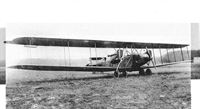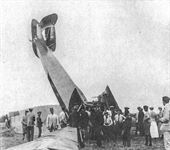
Описание
Страна: Германия
Год: 1918
O.Thetford, P.Gray German Aircraft of the First World War (Putnam)
A.E.G. G V
Produced for longer-range work than the G IV, the prototype G V appeared in May 1918. None were completed in time for operational service. In 1919 some of these aircraft were used on the first German air line Deutsche Luftreederei, one machine flying from Berlin to Eskjo in Sweden in 4 hr. 7 min. Engines, two 260 h.p. Mercedes D IVa. Span, 27.24 m. (89 ft. 4 1/2 in.). Length, 10.8 m. (35 ft. 9 1/2 in.). Height, 4.5 m. (14 ft. 9 1/8 in.). Weights: Empty, 2,700 kg. (5,940 lb.). Loaded, 4,600 kg. (10,120 lb.). Speed, 145 km.hr. (90.625 m.p.h.). Climb, 1,000 m. (3,280 ft.) in 6 min. Duration, 5-6 hr. Armament, 2/3 manually operated machine-guns. 600 kg. (1,320 lb.) bombs.
Описание:
- O.Thetford, P.Gray German Aircraft of the First World War (Putnam)
- J.Stroud European Transport Aircraft since 1910 (Putnam)
- J.Herris AEG Aircraft of WWI (A Centennial Perspective on Great War Airplanes 16)
- J.Forsgren Swedish Military Aircraft 1911-1926 (A Centennial Perspective on Great War Airplanes 68)
- M.Dusing German Aviation Industry in WWI. Volume 1 (A Centennial Perspective on Great War Airplanes 84)
Фотографии
-
J.Herris - AEG Aircraft of WWI /Centennial Perspective/ (16)
AEG G.V G.625/18
-
J.Herris - AEG Aircraft of WWI /Centennial Perspective/ (16)
AEG G.V G.644/18
-
J.Herris - AEG Aircraft of WWI /Centennial Perspective/ (16)
AEG G.V 9504 in Swedish service postwar
-
J.Forsgren - Swedish Military Aircraft 1911-1926 /Centennial Perspective/ (68)
AEG G.V 9504 in Swedish service.
-
M.Dusing - German & Austro-Hungarian Aero Engines of WWI. Vol.2 /Centennial Perspective/ (65)
Final member of the AEG bomber family was the AEG G.V, which was an extended-span, three-bay development of the G.IV. The additional wing area enabled it to carry a heavier bomb load; it used the same 260 hp Mercedes D.IVa engines as the earlier G.IV. Servo-tabs were added to the ailerons to reduce the heavy control forces for the pilot.
-
J.Forsgren - Swedish Military Aircraft 1911-1926 /Centennial Perspective/ (68)
View of AEG G.V 301/18 in German markings during the war showing its enlarged, three-bay wing with Flettner tabs to reduce the pilot's aileron control forces. The AEG G.V may have been the best German night bomber to see combat. The AEG G.V was an extended-span development of the G.IV that could carry a heavier bomb load due to its larger wing area. It had a 'box' tail to provide more control authority for better handling in case of engine failure. The first AEG G.V bombers were delivered in August 1918 and 37 were delivered by October of the 50 ordered.
-
J.Herris - AEG Aircraft of WWI /Centennial Perspective/ (16)
AEG G.V anchors a display of late-war aircraft, perhaps postwar.
-
J.Herris - AEG Aircraft of WWI /Centennial Perspective/ (16)
Front view of AEG G.V 644/18 emphasizing the three-bay wings and distinctive Flettner tabs on the ailerons. The port engine has been removed, perhaps for maintenance.
-
J.Herris - AEG Aircraft of WWI /Centennial Perspective/ (16)
Additional view of AEG G.V 644/18 showing more detail of its ailerons with Flettner tabs to reduce the pilot's aileron control forces. The AEG G.V was the best two-engine German bomber in service at war's end. For some reason the port engine of this aircraft has been removed.
-
J.Herris - AEG Aircraft of WWI /Centennial Perspective/ (16)
Additional view of AEG G.V 644/18 showing more detail of its ailerons with Flettner tabs to reduce the pilot's aileron control forces.
-
J.Herris - AEG Aircraft of WWI /Centennial Perspective/ (16)
Side view of an AEG G.V 644/18; power was from a pair of 260 hp Mercedes D.IVb engines like the earlier G.IV.
-
J.Herris - AEG Aircraft of WWI /Centennial Perspective/ (16)
Side view of an AEG G.V of the second batch showing the Flettner tabs and 'box' tail with twin rudders.
-
J.Herris - AEG Aircraft of WWI /Centennial Perspective/ (16)
AEG G.V undergoing adjustment of its ailerons and Flettner tabs.
-
J.Herris - AEG Aircraft of WWI /Centennial Perspective/ (16)
Rear view of an AEG G.V highlighting its massive wing span and 'box' tail.
-
J.Herris - Weird Wings of WWI /Centennial Perspective/ (70)
Rear view of an AEG G.V showing the 'box' tail with twin rudders to better advantage.
-
J.Herris, J.Leckscheid - Fokker Aircraft of WWI. Vol.5: 1918 Designs Part 1: Prototypes & D.VI /Centennial Perspective/ (55)
The Fokker V17 monoplane fighter prototype provides an interesting contrast to the AEG G.V and emphasizes the size of the G.V.
Другие самолёты на фотографии: Fokker V17/V20/V23/V25 - Германия - 1917
-
J.Herris, J.Leckscheid - Fokker Aircraft of WWI. Vol.5: 1918 Designs Part 1: Prototypes & D.VI /Centennial Perspective/ (55)
The Fokker V17, work number 2147, powered by a 110 hp Oberursel UR.II participated in the First Fighter Competition. Here it is parked next to an AEG G.V to contrast the difference in size.
Другие самолёты на фотографии: Fokker V17/V20/V23/V25 - Германия - 1917
-
J.Herris - AEG Aircraft of WWI /Centennial Perspective/ (16)
AEG built a wide variety of warplanes but is probably best known for its twin-engine bombers. Here is G.V G.625/18, an example of the final production AEG bomber. The G.V was based on the G.IV with its wing enlarged in span and area for more lift to carry the desired 1,000 kg bomb load, requiring an additional bay of struts. A 'box' tail gave better control during asymmetric thrust after loss of an engine, and the Flettner tabs on the ailerons reduced control forces, making the large bomber easier for the pilot to fly. The G.V was powered by two 260 hp Mercedes D.IVa engines.
The outrigger hinged aileron tab was attached by a rod to the aileron operating linkage. When the control surface was actuated, the tab moved in the opposite direction and partially balanced the aileron movement, making it easier to operate. It was thus not a true servo tab; its patented name was Flettner Hilfsruder (assisted rudder). It made the aircraft of the G class less tiring to fly and was in use in a variety of forms on the late models of twin-engined bombers. (British Air Ministry technical reports of 1919 indicate complete ignorance of the aerodynamic properties employed!) -
A.Imrie - German Bombers /Arms & Armour/
There was disbelief about the relatively small numbers of machines in use when bombers of the Bogohl were handed over to the Allies after the war, and this is surely the highest tribute that could be paid to the devotion to duty of the Bogohl commanders and their crews. This AEG G V (635/18) is shown at Avere aerodrome after the Armistice with a Gotha G Vb in the background. All the machines at this aerodrome were of the latest types, having the aerodynamic refinements that have already been mentioned, but in a last defiant gesture all the bombers had been damaged in various ways to prevent them from flying again.
-
J.Herris - AEG Aircraft of WWI /Centennial Perspective/ (16)
German bombers photographed postwar. The two aircraft at the top of the photo are AEG G.V bombers. A Gotha G.V is at bottom left and another AEG G.V is at bottom right.
Другие самолёты на фотографии: Gotha G.V - Германия - 1917
-
J.Stroud - The World's Airliners /Putnam/
An A.E.G. G V twin-engined bomber converted for passenger service with Deutsche Luft-Reederei.
Many of the first passengers flew in the open cockpits of bomber aircraft. The A.E.G. G V seen here was operated by Deutsche Luft-Reederei. It is not known whether the passengers were having a farewell drink or celebrating their arrival. -
M.Dusing - German Aviation Industry in WWI. Volume 1 /Centennial Perspective/ (84)
AEG G.V Civil (1918)
-
J.Herris - AEG Aircraft of WWI /Centennial Perspective/ (16)
AEG G.V 301/18 in American hands postwar.
-
J.Herris - AEG Aircraft of WWI /Centennial Perspective/ (16)
AEG G.V in Sweden postwar. The snow indicates this may be the first aircraft 1708/18, delivered 23 November 1918 before the purchase contract was signed.
-
J.Forsgren - Swedish Military Aircraft 1911-1926 /Centennial Perspective/ (68)
AEG G.V in Sweden postwar. The snow indicates this may be the first aircraft 1708/18, delivered 23 November 1918 before the purchase contract was signed.
Although the AEG G.V's saw limited use for long-range reconnaissance, their most valuable contribution to the AFK (and FVM) was the 260 h.p. Mercedes engines. Via Swedish Aviation Historical Society -
J.Herris - AEG Aircraft of WWI /Centennial Perspective/ (16)
On November 29, 1918, less than three weeks after the end of the war, AEG sold six AEG G.V bombers to Sweden. In fact, the first G.V, 1708/18, had already arrived at Eksjo on 23 November!
-
J.Herris - AEG Aircraft of WWI /Centennial Perspective/ (16)
AEG G.V during its delivery flight to Sweden.
-
J.Herris - AEG Aircraft of WWI /Centennial Perspective/ (16)
Crash of AEG G.V 1710/18 in Sweden Aug.13, 1919.
-
J.Forsgren - Swedish Military Aircraft 1911-1926 /Centennial Perspective/ (68)
AEG G.V serial number 9504 lasted only a few weeks before being written off at Malmen in June 1919.
AEG G.V after its crash in Sweden in 1919 displays under-fuselage details not normally visible in photos. Swedish markings have already been applied over the German night-bomber printed camouflage fabric. -
J.Herris - AEG Aircraft of WWI /Centennial Perspective/ (16)
AEG G.V 9504 after its crash in Sweden in 1919.



































